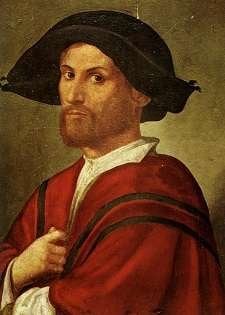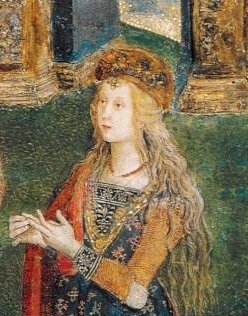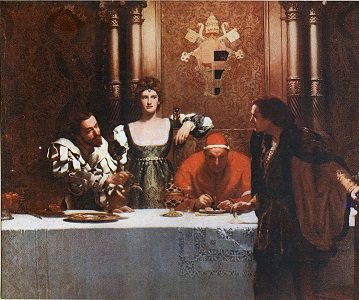Cesare Borgia, the Merciless Prince

Cesare was born in 1475 to a 44 year old cardinal named Rodrigo Borgia and his mistress Vannozza dei Cattanei. Vannozza was actually married a church officer named Domenico d’Arignano, but this was openly acknowledged to be a sham marriage and Rodrigo acknowledged Cesare as his own child, along with his other three children by Vannozza – Lucrezia, Giovanni [3] and Gioffre. Rodrigo had an older son, Pedro Luis, who inherited the Spanish titles that his father’s ecclesiastical office barred him from. As a result Cesare was educated and groomed to enter the church. In 1492 Pope Innocent VIII died. The division of the college of Cardinals between Milanese and French influences, along with the other Italian city-states that dominated the church politics in Rome, led to Rodrigo emerging as a compromise independent candidate. His uncle had been Pope forty years earlier, and the 61-year old cardinal had served in Rome since then, earning a reputation for intelligence and even-handedness that meant that there were no strong objections to his election. On 11 August he was elected Pope, taking the name of Alexander and declaring his intention to be “magnificent”. Cesare’s father was now one of the most powerful men in Christendom.

Unfortunately, Cesare turned out to be ill-suited for a priestly life. His vows of chastity clearly meant as little to him as his father’s had, as he contracted syphilis [4] in 1497 in Naples, while acting as his father’s delegate. His temper too did little to endear him to his fellow churchmen. To make matters worse, it was not his elder brother who was receiving the glory and military commands he desired, but his younger. Pedro Luis had died in 1588, and his titles had passed to Giovanni, who was Alexander’s favourite son. The two brothers seem to have clearly despised each other, evidenced by them both taking the same woman (Sancha of Aragon – ironically the wife of their younger brother Gioffre) as mistress. So, naturally, when Giovanni’s corpse was dragged out of the river then Cesare was a chief suspect in the public eye.
The evidence against Cesare is circumstantial at best, of course. On the 7th June 1497 the pope made the city of Benevento, the centre of the Papal States, a Duchy and made Giovanni the first Duke of Benevento. With him already the Captain-General of the papal armies, this marked a clear plan to have him lead an attempt to enforce the temporal power of the church on the surrounding kingdoms, exactly the type of military campaign Cesare craved. Meanwhile, Cesare was appointed a papal legate, in order to go and crown the new King of Naples. Clearly he would not have been happy with this ceremonial post. On the 14th July, the two brothers dined at their mother’s house, then set off back to the Vatican. While at supper they were joined by a mysterious masked man, who had visited Giovanni several times over the previous month. On their way back to the Vatican the two brothers split up, with Giovanni, the masked man, and a single footman heading off “in pursuit of further pleasure”. In a square the Duke told his one servant to wait for an hour, and if he did not return then to head to the Vatican. He was never seen alive again.

The next day there was consternation at Giovanni’s absence, which turned into panic when news reached them that his servant had been attacked while waiting in the square and mortally wounded. Agents immediately began making enquiries, and found a wood dealer who had been standing guard over his wood to prevent it being stolen that night. He had seen a group of men take a body dressed in fine clothes into the river, weigh it down with stones and sink it. Based on this the pope summoned all the boatmen and fishermen of the city, and hired them to scour the area. [5] Three hundred men answered the call, and eventually one of them found the corpse of the Duke of Gandia. He had been stabbed, but still had thirty ducats in his belt. Alexander was inconsolable at the news, and refused to eat for several days.
Eventually however he began to think about his family’s future. Giovanni’s son Juan, the new Duke of Gandia, was still a child. Alexander had two sons left, Cesare and Gioffre. Gioffre was a weak reed – Cesare was his only hope. The only problem was that Cesare was a Cardinal. No Cardinal in the entire history of the Church had ever voluntarily left the office. To do this would require royal support, and Alexander’s previous patron, the King of Spain (a second cousin of the spouses of Lucrezia and Gioffre), was unwilling to support this as it would weaken his own position in several manoeuvrings he had going on. Alexander was forced to break that alliance and seek a new one with the King of France. As a result Cesare resigned as Cardinal of Valencia, and became the Duke of Valentinois. The combination of the two titles gave him his nickname – Valentino.
The alliance with France was a tenuous one, and to cement it Cesare was married to Charlotte of Albret, sister of the King of Navarre. Navarre was an ally of France against Spain. However, Cesare was still worried that his father would decide to reconcile with Ferdinand of Aragon, the King of Spain, especially since his sister Lucrezia was still married to Ferdinand’s cousin. There was only one solution – Alfonso had to die. Fearing something of the sort, Alfonso had left Rome in the August of 1499, but at her family’s suggestion Lucrezia wrote to him appealing for him to return for the birth of their child, a son who was born in October. Alfonso managed to be persuaded to stay in the Vatican, and the danger seemed to have passed. Rumors of communications between Alexander and Ferdinand, however, proved fatal for him. At the entrance of St Peter’s Basilica he was attacked by a group of mercenaries and severely wounded, though his bodyguards managed to drive them off before they could kill or abduct him. He was taken to the Borgia apartments, where his sister and his wife tended to him. Once it became clear that his wounds would not be fatal, a group of armed men led by Micheletto Corella, a university friend of Cesare’s who was now one of his generals, broke into the apartment and strangled Alfonso in his bed. His wife and sister could only watch as he died, and with him any chance of the alliance with Spain being renewed.

With Cesare’s position secure, there was work to be done. The Papal States had previously been ruled by Vicars – non-priest nobles who held their lands in fealty to the Vatican. This had become largely a ceremonial thing, so it came as a shock in 1500 when Alexander declared them all deposed, and most immediately revolted. Most of these vicars were unpopular with their people, so Cesare had a lot of support as he led the armies out to depose them. With French aid he conquered the cities of Imola and Forli. The ruer of the latter, Caterina Sforza, surrendered to the French troops as she knew they did not believe in keeping female prisoners – unfortunately for her they immediately turned her over to Cesare. Strong rumours indicate that Cesare took advantage of this to rape the woman who had insulted him from atop her castle walls, and she remained a prisoner in the Vatican for several months.
Cesare returned to Rome and received a triumphal entrance reminiscent of those of the ancient Romans. The French troops returned home, but the creation of twelve new Cardinals (and the selling of their offices) raised enough funds to hire mercenaries to bolster his forces. He conquered the remainder of the Romagna, the rich fertile lands around Rome, and was granted the title of Duke of the territory. In 1502 he set out to conquer Bologna, but his mercenary generals decided to try to revolt and seize control of the lands they had conquered. Cesare persuaded them to meet with him to discuss a possible compromise, then had them all seized and executed. With his holdings secure, Cesare looked to have a shot at bringing most of central Italy under papal control. Until Alexander died.

The sickness that claimed his father’s life also nearly ended Cesare’s, as both men caught it at the same time. At the time it was speculated that it was a poisoning attempt, but to modern ears it sounds more like malaria, which was rife in Rome at the time. Weakened by the disease, Cesare was unable to properly bring his influence to bear on the succession. The immediate successor to his father, Pius III, supported and reconfirmed him in his position – unfortunately he died after only 26 days in office. His successor, Julius II, was not a fan of Alexander or his children. He declared them damnatio memoriae:
I forbid under the pain of excommunication anyone to speak or think of Borgia again. His name and memory must be forgotten. It must be crossed out of every document and memorial. His reign must be obliterated. All paintings made of the Borgias or for them must be covered over with black crepe. All the tombs of the Borgias must be opened and their bodies sent back to where they belong – to Spain.
Cesare left the city for Naples, but there he was arrested and imprisoned. The papacy revoked his dukedom over the Romgna, and took the lands back for itself. Cesare was transferred to Spain, as Ferdinand II had not forgotten the man who killed his cousin. There he was held for two years, before he managed to escape and fled to Navarre, which was ruled by his brother in law, King John III. The king was in need of an experienced general, as he was worried about invasion from Spain. Cesare led a force which recaptured one rebellious province. When they laid siege to the castle that ruled it, however, Cesare foolishly gave chase to a party of knights that attempted to break out of the encirclement. He was used to his experienced mercenaries, who would have supported him in the chase, but his soldiers disliked him and let him give chase alone. Once the knights realised they had only a single pursuer they turned and attacked him, overwhelming and killing him before robbing his corpse of all of his possessions, including the leather half-mask he wore to conceal his facial blemishes from syphilis. The son of the most powerful man in Christendom was left a naked corpse in the middle of the road.

Cesare was buried in a marble tomb in Viana by his brother in law, but sometime in the next century it was destroyed by enemies of the Borja, and he was reburied in the street outside “to be trampled by those who passed”. His reputation, too, suffered a similar posthumous degradation. The first writer to mention him extensively was Niccolò Machiavelli. He admired Cesare’s utilitarianism, believing he embodied the principle of “necessary violence”, and regarded his method of dealing with his treacherous mercenary generals as a masterstroke. On the other hand, he felt that the need to rely on mercenaries was a sign of a bigger problem – that Cesare’s power all flowed from his father, and that he failed to establish an independent power base. When his father died, it thus left him isolated and vulnerable. It is not Machiavelli’s considered approach that has become the most enduring image of Cesare, however. For that we must turn to Alexandre Dumas. His book “Celebrated Crimes” devoted an entire section to the Borgias, who he used as a convenient target for his anti-clerical bias. The historical view of the Borgias owes a lot more to his lurid fiction than to reality. Yet while Alexander and Lucrezia may not have deserved to have their reputations ruined by an esteemed author’s attack piece, I find it hard to say the same for Cesare. One must have a reputation to ruin, after all.
Images via wikimedia.
[1] One rumour/theory has it that the popular (but historically inaccurate) image of Jesus as a white-skinned bearded man used in Catholic paintings is based on Cesare.
[2] Possibly the most infamous pope was Benedict IX, who was accused of committing rape several times while in office, and who eventually sold the papacy in 1045 to Gregory VI.
[3] Also known as Juan – several of Rodrigo’s children used both the Spanish and Italian versions of their names, like Gioffre/Jofré. Indeed, “Borgia” is an Italianized version of “de Borja”.
[4] Syphilis, which only emerged as a disease in the mid-15th century, was endemic among the upper classes and priesthood at the time. The mental derangement caused by the disease helps to explain the irrational behaviour of a lot of players in Renaissance politics.
[5] Leading to many cruel jokes at the time about the Pope being a “fisher of men”.
